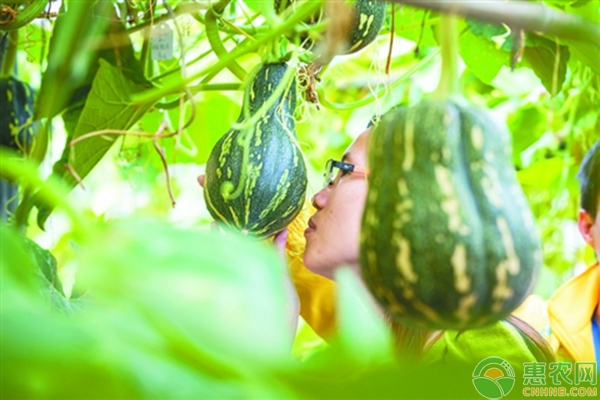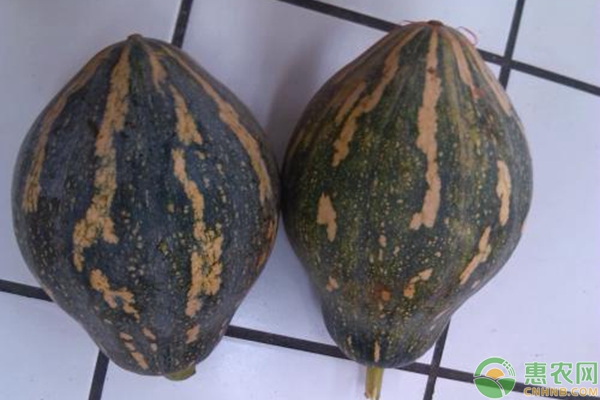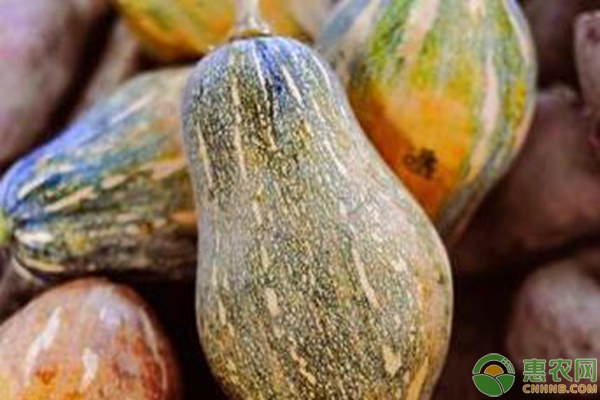Citron squash is a genus of Cucurbitaceae, which can be eaten by both tender and old melons. It is named after its scent. In 2015, Shaoguan City Agricultural Science and Technology Promotion Center introduced the successful trial of camphor pumpkin; from 2016 to 2017, the vegetable planting professional cooperatives and family farms in Shaoguan City have accumulated more than 500 mu of planting and planting, and the yield per mu exceeds 2,500 kg, and the output value per mu exceeds 10,000 yuan. Driven farmers to increase income. The following Hui Nongwang Xiaobian will tell you about the high-quality and efficient cultivation techniques of Shaoguan City citron pumpkin.

1 Characteristics of citron pumpkin
Citron squash is a medium-early maturity variety, a short-day plant with a warm temperature, strong heat and moisture resistance, suitable for planting in fertile, neutral or slightly acidic sandy loam soil. The disease resistance is strong, the plant grows vigorously, the branching ability is strong, and it is easy to make melon. Cucurbit gourd shape, 22 to 25 cm long and 13 to 15 cm in transverse diameter. Female flowers can be harvested about one month after opening, and each plant can produce 2 to 5 finished melons at the same time. The weight of single melon is 1.5-2.0 kg, the growth period is 90-100 days, and 400-450 plants per acre are suitable. The ripe melon skin is orange-yellow and has a dark green pattern. The meat is dense and fragrant, with a strong scent.
2 Cultivation techniques
2.1 Selecting the base fertilizer to select the convenient drainage, deep soil or hillside, fertile, neutral or slightly acidic sandy loam as well. Acre farmyard manure 3 000 ~ 3 500 kg, compound fertilizer 15 kg, superphosphate 10 kg, potassium sulfate 10 kg as the base fertilizer. The fertilizer is burrowed or ditched and applied deep, and the black film is covered with grass after fertilization.
2.2 Sowing
2.2.1 Seeding period. Citron squash is suitable for cultivation in open fields and protected areas. The spring broadcast in Shaoguan City is from February to March, and the autumn broadcast is from July to mid-August. Spring sowing is best to transplant after the seedlings are concentrated, and the autumn sowing is mostly live broadcast (also can be transplanted).
2.2.2 Seeding methods.
1) Live broadcast. The autumn sowing of the camphor pumpkins is usually carried out by means of live broadcast. Generally, 2 to 3 seeds are planted per hole. If the seed germination rate is lower than 85%, the seeding rate can be appropriately increased, and 3 to 4 seeds per hole are sown. Soak seeds in water for 1 to 2 hours before sowing, then remove the seeds and soak them in hot water of about 55 °C for about 15 minutes. Then rinse the seeds out and rinse them out. Cover the soil 5-8 cm after sowing, and then water it properly.

2) Seedling transplanting. The spring sowing of the squash squash is carried out by means of centralized seedling transplanting, which is convenient for seedling management and ensuring the number of seedlings. Seeds and nursery beds are disinfected prior to seedlings. The nursery bed can be fully disinfected by spraying with a broad-spectrum agent such as thiophanate-methyl or carbendazim. Seeds are first soaked in water for 1 to 2 hours, then drained and drained, soaked in 10% trisodium phosphate solution for 15 minutes, then the seeds are removed and washed in an incubator for germination. During the germination process, the temperature of the incubator is kept at 25-28 °C; the seeds should be covered with a wet towel, and the seeds should be inspected and turned frequently, washed once a day with water for 1 or 2 times to renew air and maintain humidity. After the seeds are germinated, they are uniformly planted in the seedling tray, and one seed is planted at each hole. After sowing, cover the film and keep it warm. In general, seedlings can be produced 2 to 3 days after sowing. Before the emergence of the seedlings, the film is generally not uncovered, and the window is not released. When the seedlings grow 3 to 5 leaves, they can be transplanted.
2.3 Transplanting and planting requires seeding and transplanting. The camphor pumpkin can be ridged or erected. Generally, flat land and good land are cultivated by ridges, and hillsides or terraces can be cultivated as mounds. When transplanting, the plant spacing is 50 cm and the row spacing is 2 m. One to two plants are transplanted per hole, and 400-450 plants per acre are suitable. After transplanting, water the roots.
2.4 Field Management
2.4.1 Intercropping. After the live seedlings, after growing to 5 leaves after emergence, if there are more than 2 seedlings per hole, remove the excess weak plants.
2.4.2 Separating racks. The fragrant pumpkin vines can be put on the cross or scaffolding to vines, or spread on the ground. In the former, the plants are ploughed and erected in time, usually when they are 7 to 10 leaves, and 3 to 4 side vines are left. The latter should be well-drained and drained when it is spread on the ground to prevent the waterlogging from causing rotten melons and pests.
2.4.3 Pollination, flower preservation and fruit preservation. Pumpkin is a typical cross-pollination crop. The rate of natural pollination is relatively low. In addition, there are many seed suppliers of citron squash, and the purity of seeds is uneven. The natural pollination is often not effective, so it is necessary to carry out artificial supplementary pollination. In particular, artificially assisted pollination must be carried out in protected areas. When male and female flowers are open, they should be artificially pollinated every morning from 6 to 7 o'clock, and 3 to 4 female flowers should be given. 2 to 3 melons should be selected for each vine, and the rest should be removed as soon as possible. After staying in the melon, top the 5~7 leaves of the melon and remove the side branches early.
2.4.4 Water and fertilizer management. Toona sinensis has strong resistance to moisture, drought and fertilizer. It should be properly topdressed and watered according to soil moisture and plant growth. Generally, there is no watering before sitting on the melon. After sitting on the melon, the water is watered for 3 to 4 times, usually once every 7 days. Combined with watering, 15-20 kg of compound fertilizer, 2-5 kg ​​of calcium magnesium phosphate and 2-5 kg ​​of potassium sulfate per mu.

2.4.5 Pest control.
1) Powdery mildew. White mold spots appear on the leaves or tender stems when damaged, and the whole leaves are covered with white powder when severe. 25% triazolone wettable powder 500 times solution, 50% antibacterial WP 500 times solution, 75% chlorothalonil WP 600 times solution, alternate spraying, 1 time interval, 3 consecutive times ~4 times.
2) Viral disease. The affected plants have yellow spots or deep and shallow mottled leaves on the leaves, and the leaves are uneven, and the stems and the parietal leaves are twisted. The more effective measures to prevent and treat viral diseases are to control the media, and we must do a good job in the prevention and control of aphids. The diseased plants should be removed as soon as possible and burned in time. At the same time, 20% hydrazine acetate copper wettable powder 500 times liquid or 1.5% phytopathic water emulsion 1 000 times liquid sprayed and sprayed, at intervals of 7 to 10 days, 3 times in a row.
3) Spot disease. The leaf spot of the victim plant is round to nearly circular, and when the humidity is large, the spot is densely colored with small black spots, and when the spot is severe, the spot is fused, resulting in partial death of the blade. It can be sprayed with 70% thiophanate-methyl WP 800 times or 50% carbendazione WP 1500 times, once every half month, twice in a row.
4) Pests. The main pests are aphids, mites, melon flies, noctuids, etc., 3% acetamiprid emulsifiable concentrate 2000 times solution, 48% chlorpyrifos EC 800-1000 times solution, l0% imidacloprid WP 3 000 ~ 4 000 times solution Spray control.
2.5 Harvesting and storage
2.5.1 Harvesting. Citron squash can harvest both tender and melon. The early melons are better for picking melons, so that the young melons that grow later can grow well and grow well. It is advisable to harvest the tender melon 10 to 15 days after the flowering. Old ripe melons are harvested 35 to 60 days after the flowers. The old melon should be harvested after it is fully mature, the wax powder is thick, scratched, and the skin color turns yellow. The squash squash prepared for storage should be cut with 5~10 cm long melons on the stalk. It is advisable to choose live vines with no ripeties, no damage, no pests, and pay attention to the lightness. It is advisable to harvest in the morning.
2.5.2 Storage. Storage should be selected in a ventilated and cool place, under the board, tiered storage, and timely removal of rotten melon, generally can be stored for 3 to 6 months.
Have you learned the detailed explanation of the planting techniques of Shaoguan City's camphor pumpkins compiled by Huinong.com? If you want to know more about agricultural technology, please pay attention to the Hui Nong School!
Rapid H.pylori Ag Test Kit (Colloidal Gold)
H.pylori ,H.pylori Ag,Antigen,Colloidal Gold,Test Cassette
Shenzhen Uni-medica Technology Co.,Ltd , https://www.unimedicadevice.com